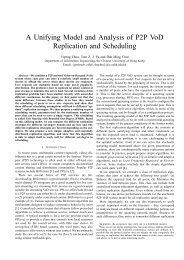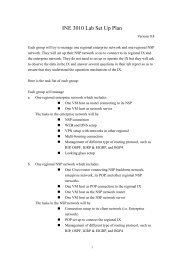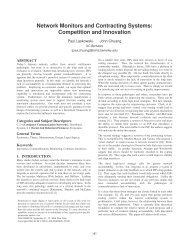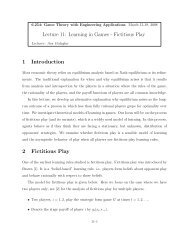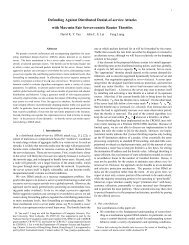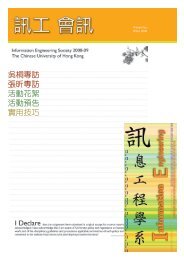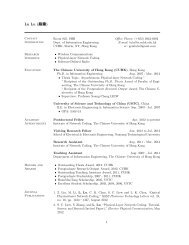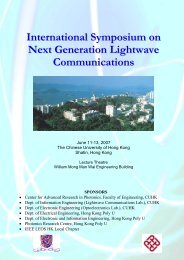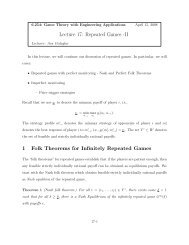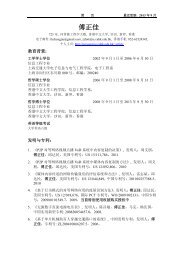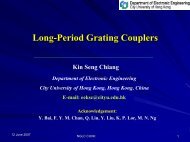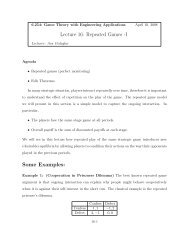Title: Nonlinear Optical Processing Of DPSK Communication Signals
Title: Nonlinear Optical Processing Of DPSK Communication Signals
Title: Nonlinear Optical Processing Of DPSK Communication Signals
Create successful ePaper yourself
Turn your PDF publications into a flip-book with our unique Google optimized e-Paper software.
p.1<br />
<strong>Nonlinear</strong> <strong>Optical</strong> <strong>Processing</strong> of <strong>DPSK</strong><br />
<strong>Communication</strong> <strong>Signals</strong><br />
Chester Shu and Mable P. Fok<br />
Department of Electronic Engineering<br />
The Chinese University of Hong Kong<br />
The Chinese University of Hong Kong<br />
Department of Electronic Engineering<br />
International Symposium on Next-Generation<br />
Lightwave <strong>Communication</strong>s 2007
<strong>DPSK</strong> Format Introduction<br />
p.2<br />
Field<br />
0 1 1 0 1 0 1 1<br />
Time<br />
<strong>DPSK</strong> format has constant amplitude for bit “0” and bit “1”<br />
<br />
<br />
<br />
<br />
Larger tolerance to degradation caused by channel-tochannel<br />
interaction through XPM<br />
Less pattern dependent gain modulation in SOAs<br />
smaller pulse-to-pulse intensity fluctuation<br />
3 dB improvement in receiver sensitivity with balanced<br />
detection<br />
When used with ASK, orthogonal modulation format can<br />
be supported<br />
The Chinese University of Hong Kong<br />
Department of Electronic Engineering<br />
International Symposium on Next-Generation<br />
Lightwave <strong>Communication</strong>s 2007
Outline<br />
p.3<br />
1. <strong>DPSK</strong> optical signal processing<br />
2. All-optical wavelength conversion<br />
3. FWM wavelength conversion in highly nonlinear bismuth oxide fiber<br />
- single pump<br />
- dual pump<br />
- polarization-diversity<br />
- polarization-multiplexed ASK-<strong>DPSK</strong> signal<br />
4. XPM wavelength conversion in SG-DBR laser integrated SOA-MZI<br />
5. Wavelength multicasting<br />
6. Summary<br />
The Chinese University of Hong Kong<br />
Department of Electronic Engineering<br />
International Symposium on Next-Generation<br />
Lightwave <strong>Communication</strong>s 2007
All-<strong>Optical</strong> <strong>Processing</strong> of <strong>DPSK</strong> signals<br />
p.4<br />
<br />
<br />
Signal regeneration<br />
- amplitude noise reduction (Fok et al., CLEO 2007, ECOC 2006)<br />
- phase noise reduction (Fok et al., OECC2007)<br />
- extinction ratio improvement (Fok et al., CLEO 2006)<br />
Wavelength conversion<br />
- dual-pump broadband (Fok et al., OFC 2007)<br />
- polarization diversity (Fok et al., CLEO 2007)<br />
- multicast wavelength conversion (Fok et al., PTL 2007)<br />
Logic operation (Fok et al., CLEO/Europe 2007)<br />
Tunable optical delay (Fok et al., OFC 2007, ECOC 2006)<br />
The Chinese University of Hong Kong<br />
Department of Electronic Engineering<br />
International Symposium on Next-Generation<br />
Lightwave <strong>Communication</strong>s 2007
Wavelength Conversion<br />
p.5<br />
Important in a wavelength routed optical network<br />
<br />
<br />
Utilization of fiber bandwidth<br />
Prevention of network blocking<br />
Examples of wavelength conversion using<br />
<br />
<br />
<br />
<br />
<br />
<br />
Sum and difference frequency generation<br />
Cross-gain modulation<br />
Cross-phase modulation<br />
Cross-absorption modulation<br />
Cross-polarization rotation<br />
Four-wave mixing<br />
The Chinese University of Hong Kong<br />
Department of Electronic Engineering<br />
International Symposium on Next-Generation<br />
Lightwave <strong>Communication</strong>s 2007
Characteristic of Four-Wave Mixing<br />
p.6<br />
Advantages:<br />
<br />
<br />
Transparent to data modulation format and bit rate<br />
Allows simultaneous conversion of multiple wavelengths<br />
Disadvantages:<br />
<br />
<br />
Narrow conversion bandwidth<br />
Polarization sensitive<br />
The Chinese University of Hong Kong<br />
Department of Electronic Engineering<br />
International Symposium on Next-Generation<br />
Lightwave <strong>Communication</strong>s 2007
Four-Wave Mixing Basic<br />
p.7<br />
signal pump 1<br />
ω 4<br />
ω ω<br />
s ω p1 ω 3<br />
E 3<br />
= (E p1 · E s<br />
*)E p1<br />
γ(ω p1<br />
– ω s<br />
) exp[i(ω 3<br />
t + ∆Φ 3 )]<br />
E 4<br />
= (E s · E p1<br />
*)E s<br />
γ(ω s<br />
– ω p1<br />
) exp[i(ω 4<br />
t + ∆Φ 4 )]<br />
field amplitudes of<br />
signal, pump 1 complex coupling coefficient<br />
∆Φ 3<br />
= 2Φ p1 – Φ s<br />
Interaction between the pump 1<br />
(ω p1<br />
) and signal (ω s<br />
)<br />
creates index grating<br />
scatters pump 2<br />
transfer phase and amplitude information<br />
signalpump 1<br />
E 6<br />
= (E p1 · E s<br />
*)E p2<br />
γ(ω p1<br />
– ω s<br />
)<br />
exp[i(ω 6<br />
t + (Φ p1<br />
– Φ s<br />
+ Φ p2<br />
))]<br />
pump 2<br />
ω<br />
ω s<br />
ω p1 ω 3 ω 7<br />
ω p2 ω 6<br />
The Chinese University of Hong Kong<br />
Department of Electronic Engineering<br />
International Symposium on Next-Generation<br />
Lightwave <strong>Communication</strong>s 2007
Highly <strong>Nonlinear</strong> Bismuth Oxide Fiber (Bi-NLF) Basic<br />
p.8<br />
<strong>Nonlinear</strong> coefficient<br />
γ = 1100 (W·km) -1 at 1550 nm<br />
2πn<br />
2<br />
γ =<br />
λA eff<br />
result from: (1) highly nonlinear nature of Bi 2 O 3<br />
(2) small effective core area<br />
Ref.: Juliet T. Gopinath,et al., JLT<br />
vol. 23, no. 11, pp. 3591-3596<br />
(2005)<br />
n 2 (m 2 /W)<br />
MFD (µm)<br />
BiO fiber 30 to 110x10 -20 1.97<br />
SiO 2 fiber 3x10 -20 10.4<br />
Short length of fiber is sufficient for four-wave mixing<br />
High SBS threshold<br />
Acknowledgement: N. Sugimoto and S. Ohara, Asahi Glass<br />
The Chinese University of Hong Kong<br />
Department of Electronic Engineering<br />
International Symposium on Next-Generation<br />
Lightwave <strong>Communication</strong>s 2007
Single Pump Four-Wave Mixing<br />
p.9<br />
<strong>DPSK</strong><br />
Signal<br />
32-cm<br />
Bi-NLF<br />
Laser<br />
BPF<br />
3-dB bandwidth = 12 nm<br />
Input Signal<br />
Converted Signal<br />
Power penalty ≤ 3 dB<br />
Signal (a.u.)<br />
Time (50 ps/div.)<br />
Signal (a.u.)<br />
Time (50 ps/div.)<br />
The Chinese University of Hong Kong<br />
Department of Electronic Engineering<br />
International Symposium on Next-Generation<br />
Lightwave <strong>Communication</strong>s 2007
Dual-Pump Four Wave Mixing for Wavelength Conversion<br />
p.10<br />
<strong>DPSK</strong> signal:<br />
Pump 1 Signal Pump 2 10-Gb/s 10 31 -1 PRBS<br />
<br />
<br />
Signal power: 17 dBm<br />
Pump power: 20 dBm<br />
Signal: 1550 nm<br />
Pump 1 : 1548 nm<br />
Pump 2 : 1543 to 1573 nm<br />
<br />
<br />
3-dB bandwidth<br />
Single-pump: 12 nm<br />
Dual-pump: >30 nm<br />
Conversion efficiency<br />
Single-pump: -20 dB<br />
Dual-pump: -18 dB<br />
Ref.: M. P. Fok et al., JThA52, OFC/NFOEC 2007<br />
The Chinese University of Hong Kong<br />
Department of Electronic Engineering<br />
International Symposium on Next-Generation<br />
Lightwave <strong>Communication</strong>s 2007
Dual-Pump Four Wave Mixing for Wavelength Conversion<br />
p.11<br />
Signal (a.u.)<br />
B2B 1545 nm 1557 nm 1568 nm<br />
Signal (a.u.)<br />
Signal (a.u.)<br />
Time (50 ps/div.) Time (50 ps/div.) Time (50 ps/div.) Time (50 ps/div.)<br />
Signal (a.u.)<br />
At BER of 10 -9<br />
Power penalty
Polarization Diversity Loop for Wavelength Conversion<br />
p.12<br />
<strong>DPSK</strong><br />
signal<br />
TL<br />
32-cm<br />
Bi-NLF<br />
output<br />
Signal (a.u.)<br />
<strong>DPSK</strong> input<br />
Time (50 ps/div.)<br />
Signal (a.u.)<br />
<strong>DPSK</strong> output<br />
Time (50 ps/div.)<br />
Ref.: M. P. Fok et al., CLEO 2007<br />
The Chinese University of Hong Kong<br />
Department of Electronic Engineering<br />
International Symposium on Next-Generation<br />
Lightwave <strong>Communication</strong>s 2007
Polarization Multiplexed ASK-<strong>DPSK</strong> Wavelength Conversion<br />
Polarization A Polarization B<br />
p.13<br />
LD<br />
ASK-<strong>DPSK</strong><br />
Generation<br />
Polarization<br />
multiplexing<br />
DL<br />
Signal (a.u.)<br />
Signal (a.u.)<br />
Time (50 ps/div.) Time (50 ps/div.)<br />
Signal (a.u.)<br />
Polarization A<br />
Time (50 ps/div.)<br />
Signal (a.u.)<br />
Polarization B<br />
Time (50 ps/div.)<br />
Ref.: M. P. Fok et al., CLEO/Europe 2007<br />
The Chinese University of Hong Kong<br />
Department of Electronic Engineering<br />
Pol B<br />
32 cm<br />
Bi-NLF<br />
Pol A<br />
BPF<br />
CW<br />
International Symposium on Next-Generation<br />
Lightwave <strong>Communication</strong>s 2007
Integrated Approach – XPM in SOA Based Device<br />
Tunable<br />
Laser<br />
CLK<br />
10 Gb/s<br />
PM<br />
<strong>DPSK</strong><br />
decoder<br />
DATA<br />
p.14<br />
DATA#<br />
Input SOA 1<br />
SG-DBR Laser<br />
Input SOA 2<br />
SOA<br />
SOA<br />
MZI SOA<br />
MZI SOA<br />
Phase<br />
Phase<br />
Signal (a.u.)<br />
Time (100 ps/div.)<br />
DATA<br />
DATA#<br />
SG-DBR Laser<br />
integrated<br />
SOA-MZI<br />
BPF<br />
Converted<br />
<strong>DPSK</strong> signal<br />
Signal (a.u.)<br />
Ref.: M. P. Fok et al., CLEO/Europe 2007<br />
Time (50 ps/div.)<br />
The Chinese University of Hong Kong<br />
Department of Electronic Engineering<br />
International Symposium on Next-Generation<br />
Lightwave <strong>Communication</strong>s 2007
DBR Laser Integrated SOA-MZI<br />
p.15<br />
Input SOA<br />
Mirror<br />
Laser SOA<br />
SG-DBR<br />
Input SOA<br />
Signal (a.u.)<br />
1548.6 nm<br />
1553.9 nm<br />
1559.1 nm<br />
1569.9 nm<br />
MZI-SOA<br />
phase<br />
Laser SOA<br />
MZI-SOA<br />
Time (200 ps/div.)<br />
<br />
By controlling the mirror<br />
of the SG-DBR<br />
wavelength tuning over 32 nm<br />
The Chinese University of Hong Kong<br />
Department of Electronic Engineering<br />
International Symposium on Next-Generation<br />
Lightwave <strong>Communication</strong>s 2007
Wavelength Multicasting<br />
p.16<br />
Wavelength multicast of <strong>DPSK</strong> signal<br />
WDM<br />
source<br />
λ pump1<br />
λ pump2<br />
λ pump3<br />
SOA<br />
BPF<br />
Ch 1<br />
6 x 10 GHz output<br />
Ch 3<br />
Ch 2<br />
Ch 5<br />
Ch 4<br />
Ch 6<br />
λ signa<br />
l<br />
TL<br />
PM<br />
BERT<br />
Output<br />
Ref.: M. P. Fok et al., PTL 2007<br />
50 ps DI<br />
The Chinese University of Hong Kong<br />
Department of Electronic Engineering<br />
Intensity (a.u.)<br />
Intensity (a.u.)<br />
Input signal<br />
Time (50 ps/div.)<br />
Multicast output<br />
Time (50 ps/div.)<br />
International Symposium on Next-Generation<br />
Lightwave <strong>Communication</strong>s 2007
Summary<br />
p.17<br />
<br />
<br />
Demonstrated all-optical processing of <strong>DPSK</strong> signals:<br />
signal regeneration, wavelength conversion, logic operation,<br />
and tunable optical delay.<br />
Achieved compact fiber and semiconductor-based approaches<br />
for tunable <strong>DPSK</strong> wavelength conversion<br />
- FWM in 32-cm Bi-NLF<br />
- XPM in SG-DBR laser integrated SOA-MZI<br />
<br />
Developed efficient <strong>DPSK</strong> wavelength multicast approaches<br />
using FWM in SOA and nonlinear PCF<br />
The Chinese University of Hong Kong<br />
Department of Electronic Engineering<br />
International Symposium on Next-Generation<br />
Lightwave <strong>Communication</strong>s 2007




